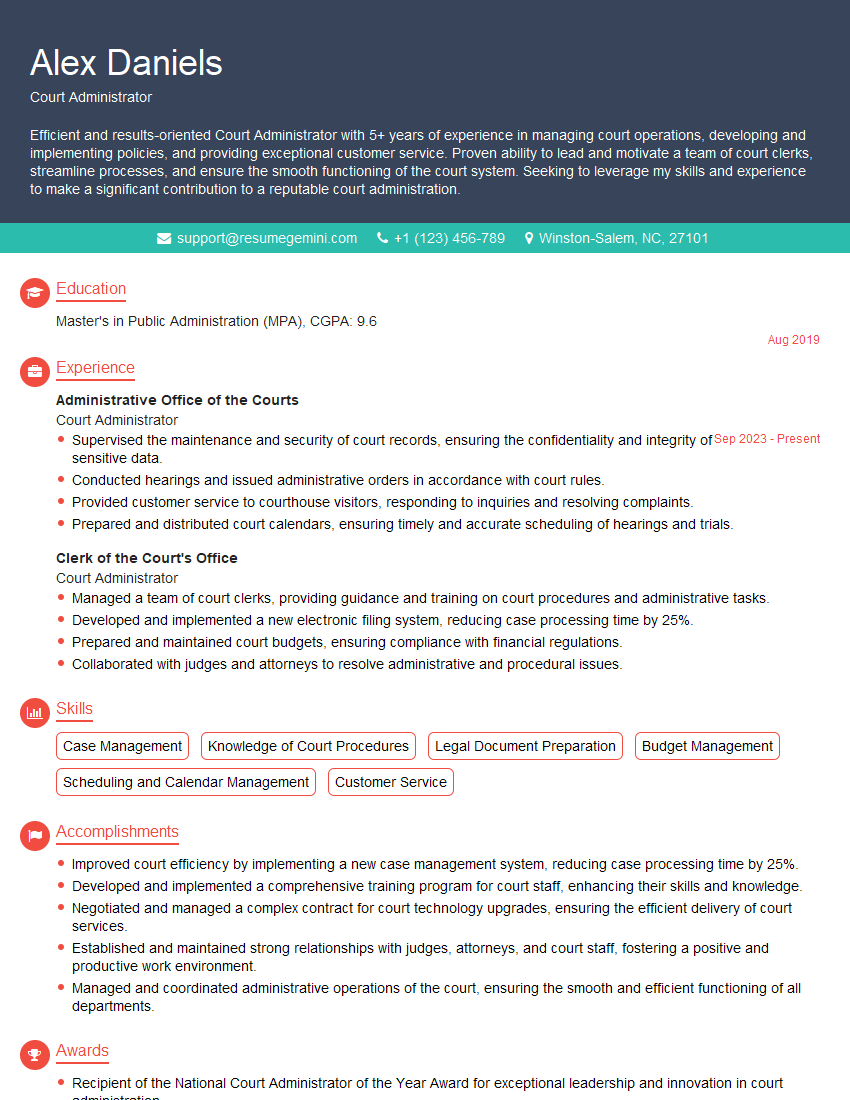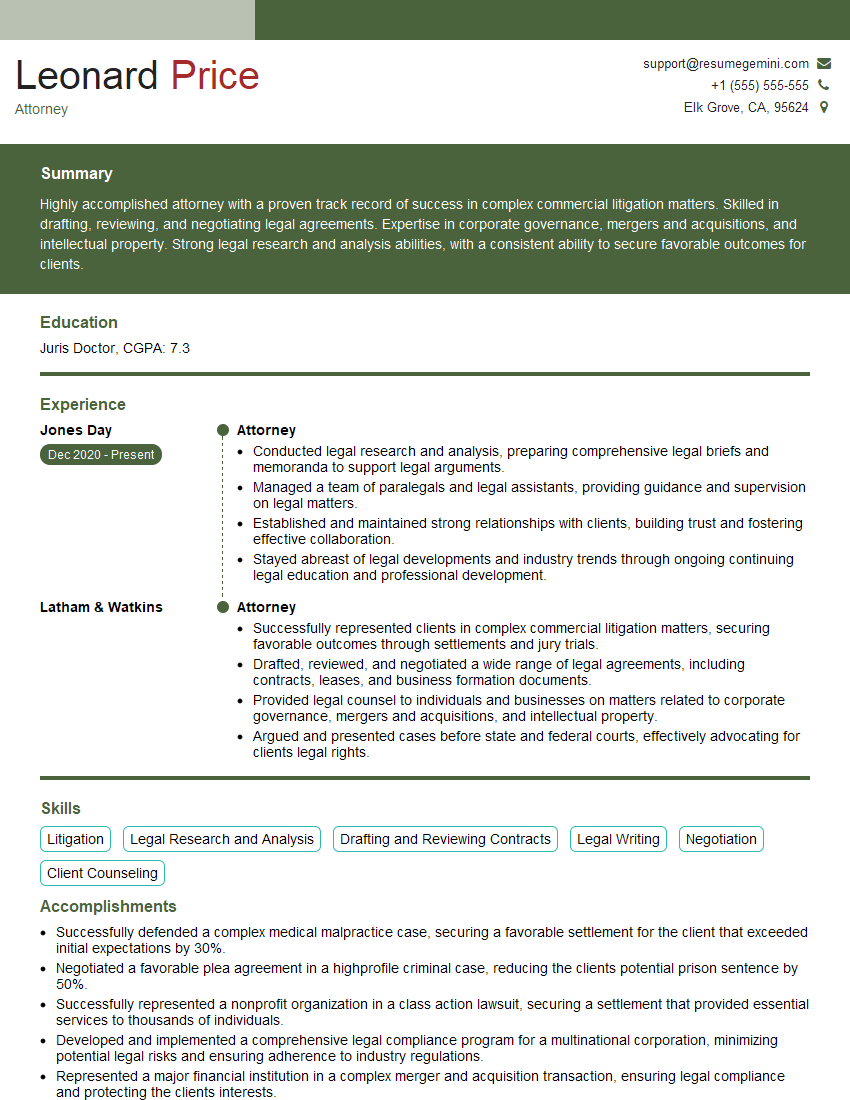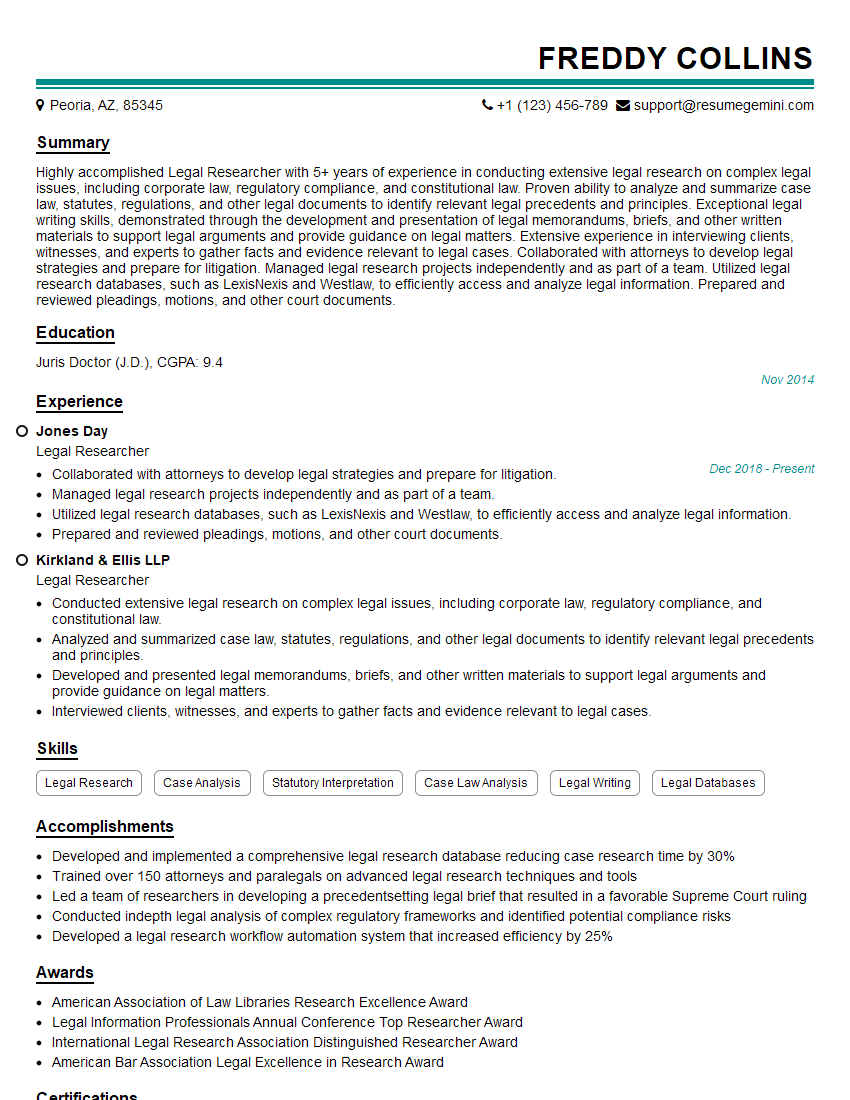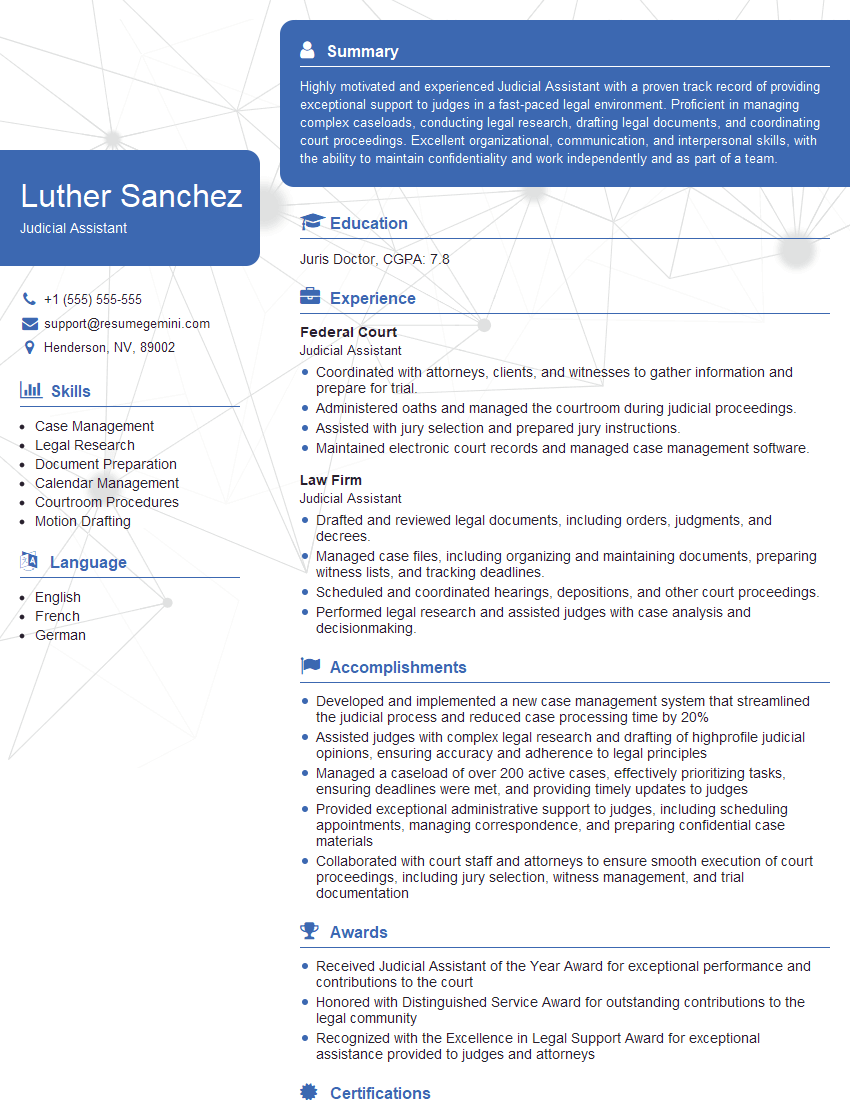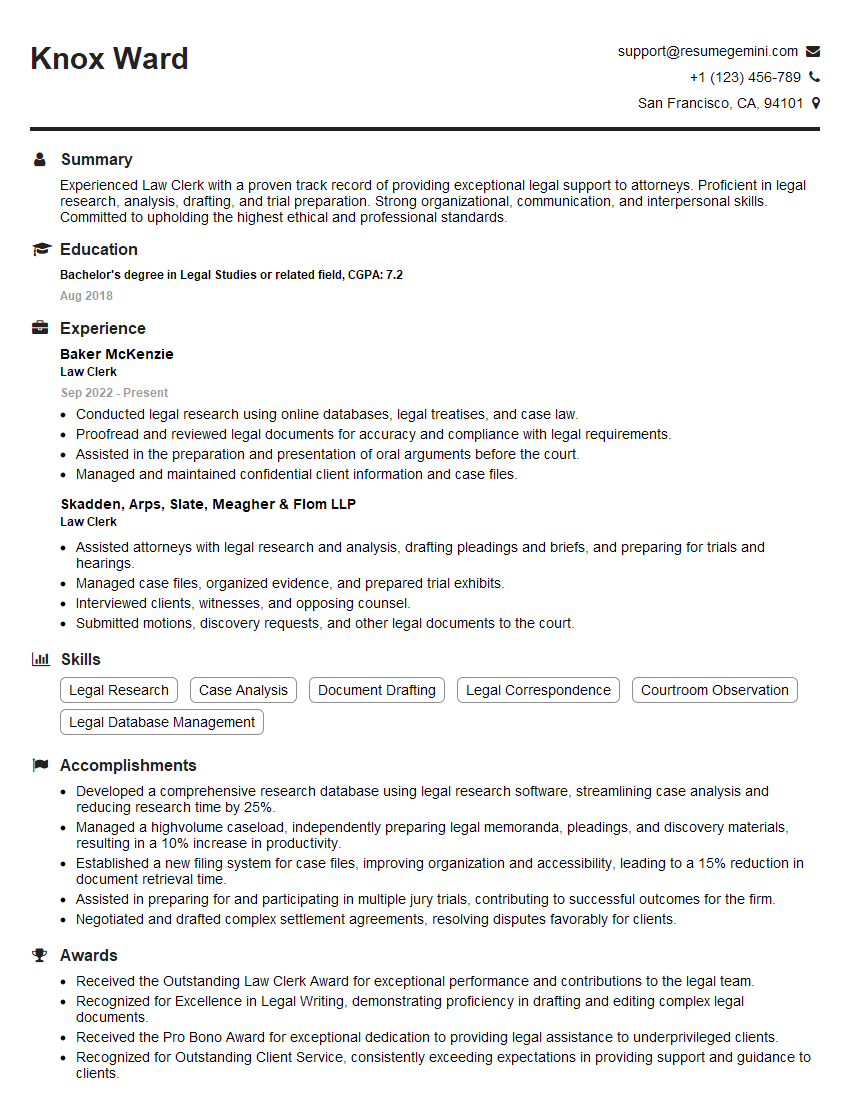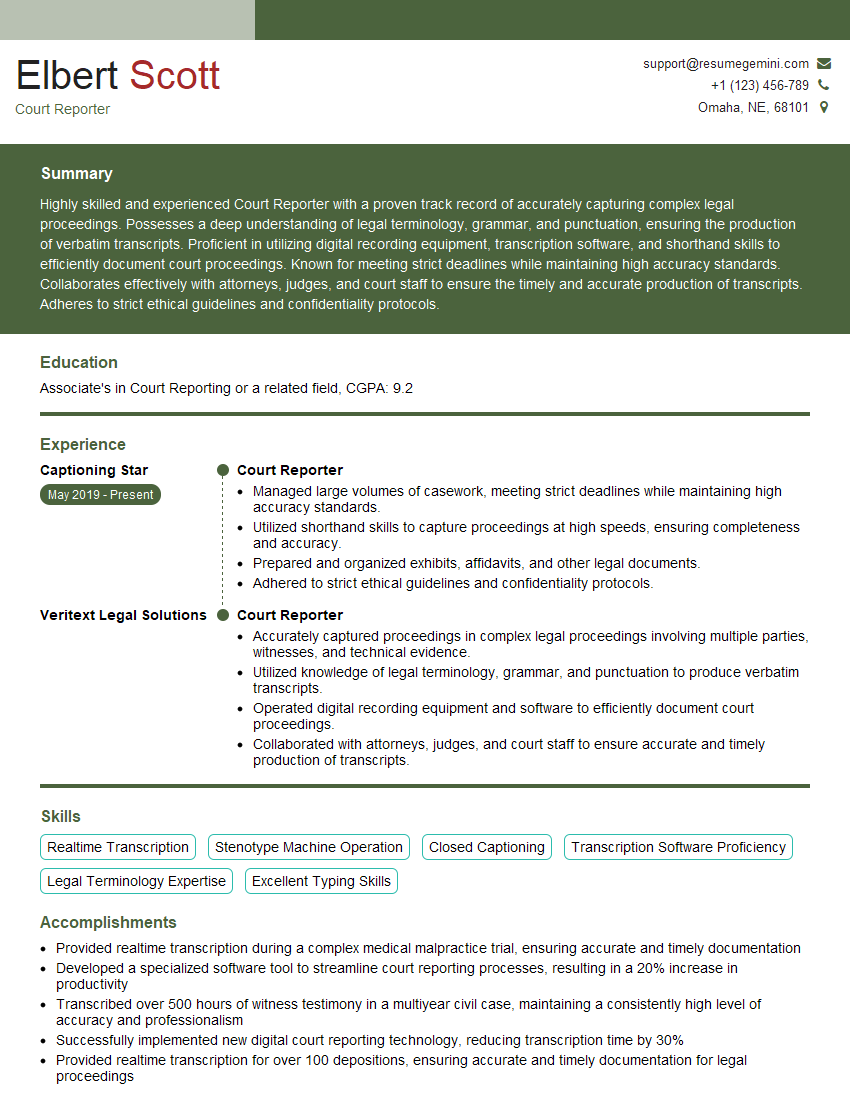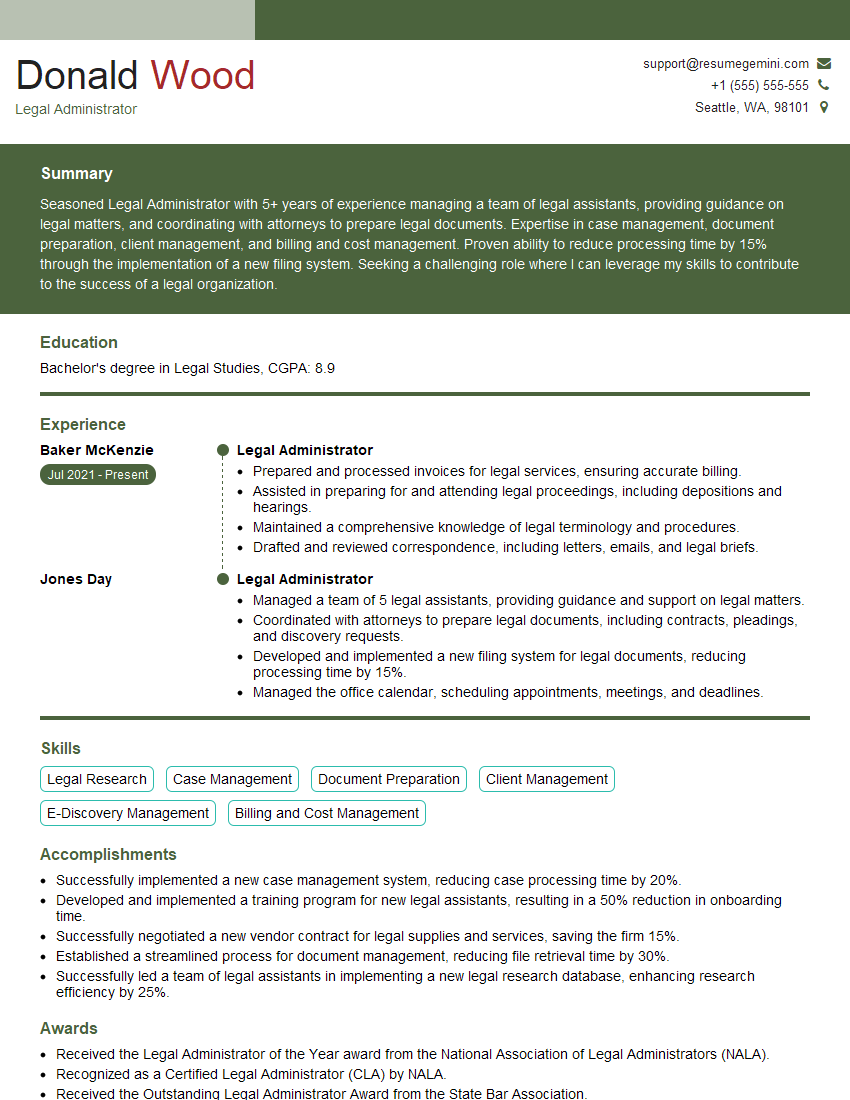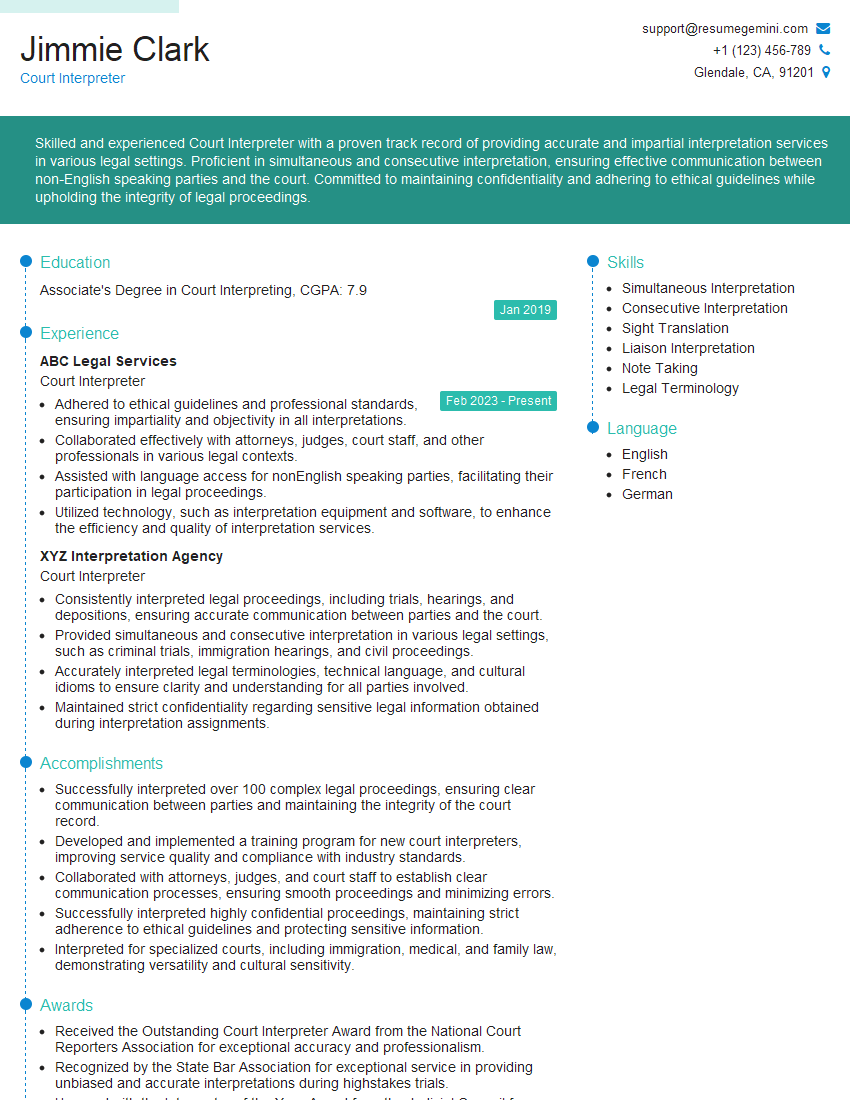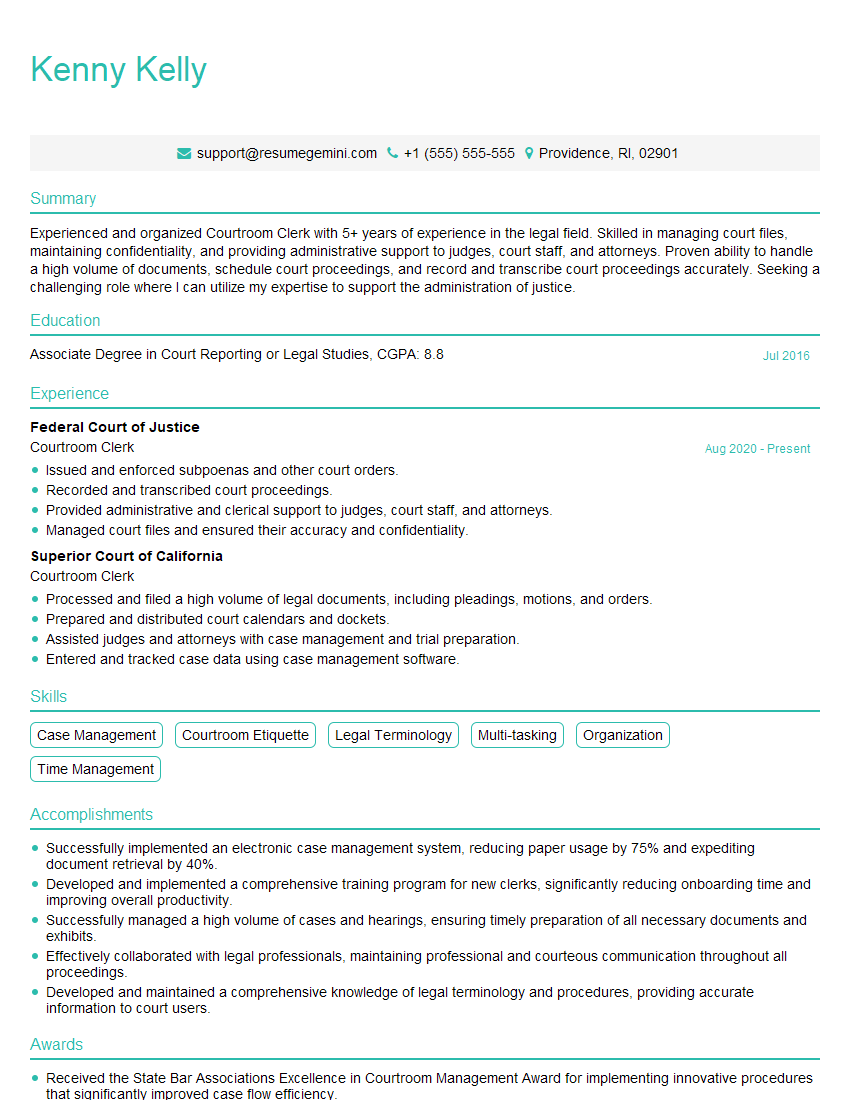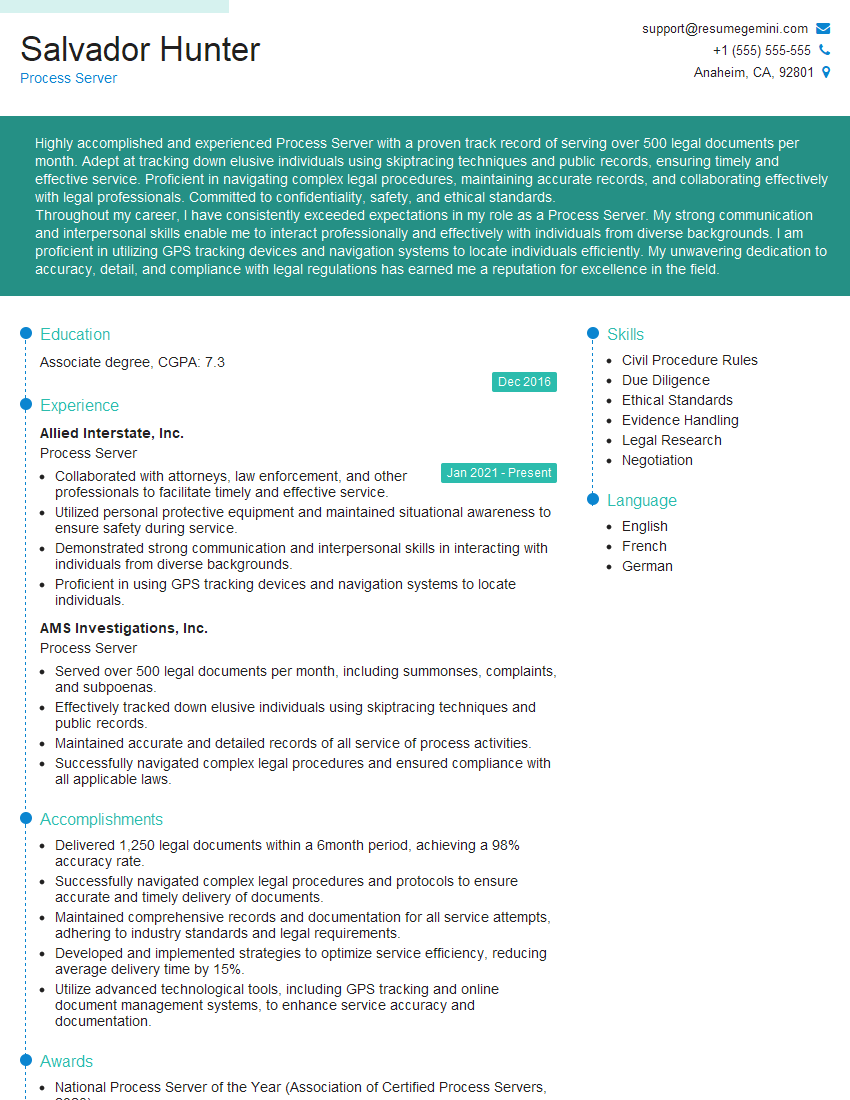Preparation is the key to success in any interview. In this post, we’ll explore crucial Maintaining Professionalism in a Courtroom Environment interview questions and equip you with strategies to craft impactful answers. Whether you’re a beginner or a pro, these tips will elevate your preparation.
Questions Asked in Maintaining Professionalism in a Courtroom Environment Interview
Q 1. Describe your understanding of proper courtroom attire.
Proper courtroom attire is crucial for maintaining respect for the court and ensuring a professional environment. It’s about projecting an image of seriousness, competence, and respect for the judicial process. The general rule is to dress conservatively and formally.
- For men: This typically means a suit (preferably dark-colored), a collared shirt, and a tie. Avoid flashy colors or patterns.
- For women: A pantsuit or a skirt suit in neutral colors is generally appropriate. Dresses should be modest and professional. Avoid low necklines, short skirts, or revealing clothing.
- For all: Clean, well-maintained shoes are essential. Avoid excessive jewelry, strong perfumes or colognes, and anything that could be distracting.
Imagine attending a crucial business meeting – you wouldn’t wear jeans and a t-shirt, right? Court is similar; it demands a level of formality that reflects the gravity of the proceedings.
Q 2. How would you handle a disruptive spectator in the courtroom?
Handling a disruptive spectator requires a calm and measured approach. My priority is to maintain order in the courtroom without escalating the situation.
- Observe and Assess: I would first discreetly observe the nature and extent of the disruption. Is it a minor outburst, or something more serious?
- Verbal Warning (if appropriate): If the disruption is minor, a quiet and polite word might suffice. I might say something like, “Sir/Madam, could you please refrain from speaking during the proceedings?”
- Court Officer Intervention: For more serious disruptions, I would immediately alert a court officer or bailiff. They are trained to handle such situations and have the authority to take appropriate action, which might include removing the disruptive individual from the courtroom.
- Document the Incident: It’s crucial to document the incident, including the time, the nature of the disruption, and any actions taken. This documentation may be necessary for later reference.
The key is to de-escalate the situation swiftly and efficiently, prioritizing the smooth functioning of the court proceedings. Thinking back to crowd control techniques, a calm, authoritative presence often prevents escalation.
Q 3. Explain the importance of maintaining confidentiality in a legal setting.
Maintaining confidentiality in a legal setting is paramount. It protects the rights and privacy of individuals involved in legal matters, upholds the integrity of the judicial system, and ensures the smooth flow of legal processes. Breaching confidentiality can have serious consequences, both legally and ethically.
- Client Confidentiality: Information shared by a client, even seemingly insignificant details, is considered confidential. This encompasses personal information, case strategy, and anything discussed during attorney-client privilege.
- Case Information: Details about ongoing cases, even those not yet public, are protected. Premature disclosure could prejudice a case or compromise the fairness of proceedings.
- Witness Information: Information provided by witnesses, including their personal details and statements, must be treated with utmost confidentiality.
Imagine a situation where confidential information was leaked about a case – it could severely impact the outcome and trust in the legal system. Confidentiality is not just a rule; it is a cornerstone of ethical legal practice.
Q 4. How do you handle disagreements with colleagues in a professional manner within a court environment?
Disagreements with colleagues are inevitable in any professional setting, including a courtroom environment. However, resolving such disagreements professionally is crucial for maintaining a productive and respectful atmosphere.
- Private Discussion: I would initiate a private conversation with my colleague to discuss the point of contention. The goal is to understand their perspective and find common ground.
- Focus on Issues, Not Personalities: I would keep the discussion focused on the specific issues at hand, avoiding personal attacks or accusatory language. The aim is to solve the problem, not to win an argument.
- Seek Mediation (if necessary): If a private conversation doesn’t resolve the issue, I might seek mediation from a senior colleague or supervisor. A neutral third party can help facilitate a productive dialogue.
- Professionalism is Key: Regardless of the outcome, I would maintain a professional demeanor throughout the process. Respectful communication is essential.
Think of it like a collaborative project where team members have different ideas – open communication and a willingness to compromise are key to achieving a successful outcome. Similarly, in a court environment, collaboration is essential, and resolving disagreements constructively ensures effective teamwork.
Q 5. What steps would you take if you witnessed unethical behavior in the courtroom?
Witnessing unethical behavior in the courtroom requires careful consideration and action. The approach depends on the severity and nature of the unethical conduct.
- Assess the Situation: Determine the seriousness of the unethical act. Is it a minor infraction or a significant breach of ethical standards?
- Document the Incident: Thoroughly document the event, including date, time, individuals involved, and a detailed description of the unethical behavior.
- Report to Appropriate Authority: Depending on the severity, I would report the incident to the appropriate authority, such as a supervisor, the judge, or the relevant professional disciplinary body. This might involve submitting a formal written complaint.
- Consider Legal Implications: In some cases, unethical behavior might have legal ramifications, and I would consider consulting with legal counsel to explore appropriate action.
Maintaining ethical conduct is crucial for the integrity of the legal system. Reporting unethical behavior, while possibly difficult, is a necessary part of upholding professional standards and ensuring a fair and just legal process. It’s about upholding the principles of justice, much like reporting a crime.
Q 6. How would you respond to a judge’s unexpected request or instruction?
Responding to a judge’s unexpected request or instruction requires immediate attention and respect. The key is to respond promptly, accurately, and professionally.
- Listen Carefully: Pay close attention to the judge’s instructions, ensuring I understand them completely.
- Confirm Understanding: To avoid any misinterpretations, I might politely repeat the instruction, such as, “Your Honor, if I understand correctly, you are requesting that…”
- Act Promptly: I would act on the instruction immediately and efficiently, within the boundaries of my authority and ethical obligations.
- Seek Clarification (if needed): If any part of the instruction is unclear, I would respectfully request clarification from the judge.
Think of it like following a boss’s instruction – clear communication, prompt action, and seeking clarification when necessary are essential for successful task completion. In a courtroom setting, this is amplified due to the formal and hierarchical structure.
Q 7. Describe your experience with maintaining accurate records in a court environment.
Maintaining accurate records is fundamental in a court environment. Accurate record-keeping ensures the integrity of legal proceedings, protects the rights of all parties involved, and allows for efficient case management.
- Detailed Record Keeping: I diligently document all relevant information, including dates, times, individuals involved, conversations, and decisions made. I use clear and concise language and maintain chronological order.
- Secure Storage: Records are stored securely, using appropriate measures to protect against loss, damage, or unauthorized access. This might include electronic storage with password protection and regular backups.
- Compliance with Regulations: I maintain strict adherence to all relevant regulations and rules regarding record-keeping, ensuring that all records meet legal and professional standards.
- Regular Review and Updates: I conduct regular reviews of records to ensure accuracy and completeness. Any necessary updates or corrections are made promptly and documented.
Imagine a scenario where crucial evidence was lost or inaccurate because of poor record-keeping. It could compromise a case severely. Accurate record-keeping isn’t merely administrative; it is crucial to the validity and fairness of legal proceedings.
Q 8. How do you prioritize tasks effectively in a high-pressure courtroom setting?
Prioritizing tasks in a high-pressure courtroom setting requires a structured approach. Think of it like a surgeon performing a complex operation – every step must be precise and timely. I utilize a combination of techniques including:
- Prioritization Matrix: I categorize tasks based on urgency and importance (urgent/important, important/not urgent, etc.). This helps me focus on the most critical tasks first, like preparing key exhibits or ensuring witness testimonies are ready.
- Time Blocking: Allocating specific time slots for particular tasks prevents multitasking and ensures focused attention. This is particularly crucial in managing deadlines and preventing last-minute rushes.
- Delegation: Where appropriate, I delegate tasks to capable team members. This frees up my time for high-priority items that demand my expertise, such as strategy discussions or addressing unexpected courtroom developments.
- Flexibility: Courtroom settings are unpredictable. I remain adaptable, adjusting my priorities as needed based on unexpected events or judge’s rulings. This requires a calm demeanor and ability to quickly reassess the situation.
For example, if a crucial witness becomes unavailable, I immediately re-prioritize tasks to secure a replacement or adapt my strategy. This adaptable approach is key to handling the dynamic nature of courtroom proceedings effectively.
Q 9. How familiar are you with courtroom procedures and protocols?
I possess extensive familiarity with courtroom procedures and protocols. My understanding encompasses various aspects, including:
- Rules of Evidence: I’m proficient in understanding and applying the rules of evidence, ensuring that all presented material is admissible and relevant to the case.
- Courtroom Etiquette: I am well-versed in proper courtroom decorum, including addressing the judge appropriately, maintaining respectful conduct, and adhering to specific rules for attorney-client communication within the courtroom.
- Trial Procedures: I understand the sequential steps of a trial, from opening statements to closing arguments, including jury selection and witness examination procedures.
- Document Handling: I’m familiar with the proper methods for submitting, presenting, and managing court documents, adhering to deadlines and specific court requirements. This includes both physical and electronic document management.
This knowledge enables me to anticipate potential challenges, prepare effectively, and contribute to a smooth and efficient legal process.
Q 10. Describe a situation where you had to remain calm and professional under pressure in a legal setting.
During a high-stakes contract dispute trial, a key witness unexpectedly contradicted their prior sworn statement. This created a significant challenge, potentially jeopardizing our case. Instead of panicking, I calmly assessed the situation.
I immediately conferred with my team, strategizing a response. We collaboratively developed a plan to address the discrepancy, focusing on highlighting inconsistencies in the witness’s testimony and presenting alternative evidence to support our claims. By remaining calm and methodically working through the problem, we successfully mitigated the damage and ultimately secured a favorable outcome. My focus on maintaining professionalism, even under pressure, prevented the situation from escalating and helped preserve the integrity of our case.
Q 11. How do you ensure the security and integrity of court documents?
Ensuring the security and integrity of court documents is paramount. My approach is multifaceted:
- Secure Storage: I utilize secure, password-protected electronic storage and physically lock away paper documents in authorized, restricted-access areas. This protects them from unauthorized access, alteration, or destruction.
- Chain of Custody: I meticulously maintain a detailed record of every person who accesses or handles court documents, ensuring a complete audit trail. This accountability prevents unauthorized modification and ensures the documents’ authenticity.
- Version Control: For electronic documents, I utilize version control systems to track changes and ensure access to previous versions. This helps in case of accidental deletion or corruption.
- Data Encryption: All sensitive electronic information is encrypted both in transit and at rest using industry-standard encryption protocols.
- Compliance with Rules: I rigorously follow all court rules and regulations pertaining to document handling, storage, and security.
This layered approach minimizes the risk of breaches and guarantees the preservation of the documents’ integrity and confidentiality.
Q 12. Explain your understanding of courtroom decorum and its importance.
Courtroom decorum refers to the established rules of conduct and etiquette that maintain order and respect within the courtroom. It’s essential for ensuring a fair and efficient legal process. It’s like the unspoken rules of a formal dinner party – everyone needs to understand and respect them for the event to run smoothly.
Its importance lies in several areas:
- Respect for the Court: Maintaining decorum demonstrates respect for the judge, the jury, and the legal process itself. This contributes to a respectful and productive environment.
- Ensuring Fairness: Proper decorum helps prevent disruptions that could prejudice the outcome of a case. Disrespectful behavior can undermine the integrity of proceedings.
- Maintaining Order: Courtroom decorum is crucial for maintaining order, ensuring that proceedings can progress smoothly and efficiently without interruptions.
- Setting the Tone: The level of decorum sets the tone for the entire proceeding. A professional, respectful atmosphere fosters confidence in the fairness and impartiality of the legal process.
Examples include addressing the judge as “Your Honor,” speaking respectfully to witnesses, and refraining from outbursts or disrespectful behavior.
Q 13. How would you handle a situation where confidential information is accidentally disclosed?
Accidental disclosure of confidential information is a serious breach that needs immediate and decisive action. My response would be:
- Immediate Containment: I would immediately halt any further dissemination of the information and try to retrieve already disclosed information, if possible.
- Notification: I would promptly inform my supervisor and the relevant parties, including opposing counsel, of the accidental disclosure. Transparency is crucial in mitigating potential harm.
- Assessment of Damage: I would work with my supervisor to assess the extent of the damage and identify any potential risks or liabilities.
- Remedial Action: We would take appropriate remedial actions, which might involve implementing additional security measures, providing notification to affected parties, or taking legal steps as needed.
- Documentation: I would meticulously document the entire incident, including steps taken to contain the breach, notification procedures, and any remedial measures implemented. This documentation is crucial for potential investigations or legal proceedings.
This structured response is crucial in minimizing potential harm and demonstrating accountability. The focus remains on preventing future incidents and addressing the immediate concerns.
Q 14. Describe your experience with handling sensitive information in a legal context.
Throughout my career, I have consistently handled sensitive information in legal contexts, including client confidential data, privileged communications, and sensitive case-related documents. My experience includes:
- Client Confidentiality: I strictly adhere to attorney-client privilege and maintain strict confidentiality of client information. I never discuss client matters with unauthorized individuals. This includes verbal and written communication.
- Data Security Protocols: I am proficient in applying data security protocols to protect sensitive information, including encryption, access control, and secure storage methods.
- Compliance with Regulations: I am knowledgeable about and compliant with relevant privacy laws and regulations, such as HIPAA (in healthcare contexts) or GDPR (for European data). This ensures the protection of sensitive information under applicable legal frameworks.
- Ethical Considerations: I prioritize ethical conduct in handling sensitive information, upholding my professional responsibility to protect client confidentiality and maintain the integrity of the legal process.
My consistent adherence to these principles ensures that sensitive information remains protected and confidential.
Q 15. How do you manage your time effectively when working on multiple legal tasks simultaneously?
Effective time management is crucial in the fast-paced legal world. I employ several strategies to juggle multiple tasks. Firstly, I prioritize tasks based on urgency and importance using methods like the Eisenhower Matrix (urgent/important, important/not urgent, etc.). This ensures I focus on the most critical matters first. Secondly, I break down large tasks into smaller, more manageable chunks. This makes them less daunting and allows for better progress tracking. Thirdly, I utilize project management tools and scheduling software to visualize deadlines and allocate time effectively. This includes setting realistic deadlines for each sub-task and building in buffer time for unexpected delays. Finally, I regularly review my schedule and adjust priorities as needed, adapting to changing circumstances. For example, if a critical court filing requires immediate attention, I will shift my focus and re-prioritize accordingly, informing relevant colleagues of any changes to the project timeline.
Career Expert Tips:
- Ace those interviews! Prepare effectively by reviewing the Top 50 Most Common Interview Questions on ResumeGemini.
- Navigate your job search with confidence! Explore a wide range of Career Tips on ResumeGemini. Learn about common challenges and recommendations to overcome them.
- Craft the perfect resume! Master the Art of Resume Writing with ResumeGemini’s guide. Showcase your unique qualifications and achievements effectively.
- Don’t miss out on holiday savings! Build your dream resume with ResumeGemini’s ATS optimized templates.
Q 16. How do you adapt your communication style to different individuals in a courtroom environment?
Adapting communication style is paramount in the courtroom. I tailor my approach based on the individual’s role and personality. When communicating with judges, I maintain a formal and respectful tone, using precise and concise language, avoiding colloquialisms. With colleagues, I foster a collaborative and professional atmosphere, engaging in open and constructive dialogue. When interacting with clients, I aim for clear and empathetic communication, ensuring they understand legal processes and their options. I utilize active listening, clarifying any ambiguities to avoid misunderstandings. For instance, with a nervous client, I would use a gentler, reassuring tone, providing more detailed explanations. Conversely, with a more assertive client, I might adopt a more direct and concise style to maintain efficiency. The key is to always be professional, respectful, and to ensure clear communication.
Q 17. How would you address a situation where you observe unprofessional behavior from a legal professional?
Observing unprofessional behavior from a legal professional requires a careful and measured response. My approach depends on the severity and nature of the misconduct. For minor infractions, like a slight lapse in decorum, a private and discreet conversation might suffice. I’d address the issue directly but respectfully, highlighting the professional standards expected in a courtroom setting. For more serious breaches, such as disrespectful conduct toward the court or unethical practices, I would first document the incident, including date, time, and witnesses. I would then consider escalating the matter to the appropriate authorities, such as a supervising attorney or the court itself, depending on the context. In all cases, maintaining my own professionalism and avoiding retaliatory behavior is paramount. This ensures that the complaint is handled appropriately and maintains the integrity of the legal proceedings.
Q 18. How do you ensure accuracy and attention to detail in your work in a legal setting?
Accuracy and attention to detail are non-negotiable in a legal context. I employ several strategies to ensure this. First, I meticulously review all documents, paying close attention to dates, names, numbers, and any other relevant information. Second, I utilize checklists and templates to maintain consistency and avoid overlooking key details. Third, I double-check my work before submitting any documents or communicating important information. Fourth, I always maintain a well-organized filing system, both physical and digital, to ensure quick and easy access to necessary documents. Finally, I leverage technology where appropriate, using tools like proofreading software and legal research databases to improve accuracy and efficiency. For instance, I’ll meticulously compare a draft contract against the original, looking for discrepancies in wording, dates, or figures. Even a small error can have significant legal ramifications.
Q 19. How do you maintain composure and professionalism when faced with challenging individuals?
Maintaining composure and professionalism when dealing with challenging individuals is essential. I approach such situations with empathy and understanding, while setting clear boundaries. I actively listen to their concerns without interrupting, trying to understand their perspective. I respond calmly and professionally, even when provoked. I use clear and concise language, avoiding emotional or inflammatory responses. If the situation escalates, I might politely but firmly remind the individual of the appropriate conduct expected in a courtroom setting. If the behavior continues to be disruptive, I would not hesitate to seek assistance from court officials or security personnel. I view these situations as opportunities to demonstrate my professionalism and resolve conflicts constructively.
Q 20. Describe your experience working effectively under tight deadlines in a legal context.
I have extensive experience working under tight deadlines in legal settings. I thrive in high-pressure environments and consistently deliver accurate and high-quality work, even under significant time constraints. My approach involves prioritizing tasks based on urgency, efficiently delegating where possible, and optimizing workflows to maximize efficiency. I am adept at managing multiple deadlines simultaneously, utilizing time management tools and clear communication to keep everyone informed of progress. For example, during a trial preparation phase, I had to finalize numerous witness statements and legal documents within a week. I organized my workload, delegated some tasks to junior colleagues while taking on the most complex ones myself. This required working long hours but resulted in timely completion of all tasks, ensuring the smooth running of the trial.
Q 21. How do you handle difficult or demanding clients or colleagues in a legal setting?
Handling difficult clients or colleagues requires a combination of empathy, professionalism, and assertive communication. I always begin by actively listening to their concerns and attempting to understand their perspective. I approach interactions with respect, regardless of their behavior, and strive to find common ground. If the issue is a misunderstanding, I clearly explain my position using facts and evidence. If the behavior is consistently unprofessional or disruptive, I will set clear boundaries, documenting the issues and escalating them to the appropriate authority if necessary. However, I always attempt to resolve issues through direct communication and collaboration first. A calm, assertive approach, coupled with clear communication, is usually the most effective strategy for de-escalating tense situations and maintaining a productive working relationship.
Q 22. How would you respond if you were accused of unprofessional conduct?
Accusations of unprofessional conduct are serious and require a calm, measured response. My first step would be to carefully listen to the accusation without interrupting. Then, I would politely request clarification on the specific instance of alleged misconduct. Following this, I would provide a factual and detailed account of the events, supported by any relevant documentation or witness testimony. It’s crucial to maintain composure, avoid emotional outbursts, and speak respectfully, even if the accusation is unfair. I believe in addressing concerns directly and honestly, while also adhering to the legal framework governing professional conduct. For example, if accused of inappropriate communication with a witness, I would present any records of interaction and highlight the professional nature of the communication, making it clear that my actions were within ethical and legal bounds.
If the matter requires further investigation, I would fully cooperate with any inquiry and present any evidence that supports my professional conduct. The goal isn’t to win an argument but to demonstrate the facts and highlight adherence to professional standards. Transparency and cooperation are paramount in such situations.
Q 23. How do you manage stress and maintain professionalism in a high-stakes legal environment?
The legal profession is inherently stressful, demanding both mental resilience and effective stress management. My approach is multifaceted. Firstly, I prioritize a healthy work-life balance. This includes regular exercise, sufficient sleep, and dedicated time for relaxation and personal pursuits. Secondly, I practice mindfulness and meditation techniques to help manage anxiety and maintain focus. These practices help me remain calm and objective even under pressure.
Thirdly, I’ve learned the importance of effective time management and prioritization. By carefully organizing my workload and delegating tasks when appropriate, I prevent feeling overwhelmed. Finally, I maintain open communication with my superiors and colleagues, seeking support and guidance when needed. This collaborative approach fosters a supportive environment and helps alleviate some of the inherent pressures of a high-stakes legal environment. Think of it like a marathon, not a sprint. Pacing oneself and employing various strategies are crucial to maintaining professionalism throughout.
Q 24. Describe your understanding of ethical guidelines relevant to courtroom conduct.
My understanding of ethical guidelines relevant to courtroom conduct is comprehensive and deeply ingrained in my professional practice. These guidelines are primarily based on principles of honesty, integrity, fairness, and respect for the court and all participants. Key ethical considerations include:
- Confidentiality: Maintaining client confidentiality is paramount, adhering to attorney-client privilege and ethical rules governing disclosure of confidential information.
- Competence: Providing competent and diligent representation, ensuring adequate preparation and knowledge of relevant laws and procedures.
- Candor to the Tribunal: Being honest and truthful with the court, refraining from making misrepresentations or presenting false evidence.
- Impartiality and Fairness: Treating all parties with respect and avoiding any conduct that could prejudice the proceedings.
- Avoiding Conflicts of Interest: Disclosing and managing any potential conflicts of interest to ensure impartiality and fairness.
These ethical principles are not merely suggestions but fundamental obligations, enforced by professional disciplinary bodies and the court’s inherent power to maintain order and decorum. A violation can lead to serious consequences, including sanctions, disbarment, and even criminal charges in some instances.
Q 25. How familiar are you with relevant rules of evidence and procedure?
My familiarity with relevant rules of evidence and procedure is extensive. I have a deep understanding of the rules governing admissibility of evidence (e.g., hearsay, relevance, authentication), the process of examination and cross-examination of witnesses, and the proper presentation of arguments before the court. I am proficient in applying these rules in various legal contexts, including civil and criminal cases.
For example, I understand the distinctions between direct and circumstantial evidence, the requirements for establishing a chain of custody for physical evidence, and the proper use of objections to challenge inadmissible evidence. My practical experience has honed these skills, enabling me to effectively navigate complex evidentiary issues and advocate for my clients while upholding the integrity of the judicial process.
Q 26. How do you handle conflicting instructions from different superiors in a legal setting?
Conflicting instructions from different superiors require careful navigation. My first step would be to respectfully clarify the instructions, seeking to understand the context and rationale behind each directive. If the conflict persists and cannot be resolved through internal communication, I would document the discrepancy clearly, outlining each instruction and the source. Then I would seek guidance from a higher authority within the legal structure, such as a supervising partner or managing attorney. My goal would be to find a solution that adheres to legal and ethical standards, while also respecting the hierarchy within the organization. I would ensure that the chosen course of action is clearly documented to prevent future misunderstandings and to maintain transparency.
It’s crucial to approach such situations professionally and avoid placing myself in a position that could compromise my ethical obligations or create liability for myself or the firm. The priority is always to act in the best interest of the client and uphold the integrity of the legal process.
Q 27. How do you maintain objectivity and neutrality in a court environment?
Maintaining objectivity and neutrality is crucial for a fair and just legal process. I achieve this through conscious effort and established practices. First, I consciously set aside any personal biases or opinions that might affect my judgment. Second, I focus on the facts presented in evidence and the applicable law, avoiding speculation or emotional responses. Third, I treat all parties involved – clients, opposing counsel, witnesses, and the court – with equal respect and courtesy.
For instance, if I have a personal connection with a witness, I would disclose that to the court to ensure transparency and avoid any perception of bias. Furthermore, I continually review and refine my understanding of legal principles to ensure my interpretations are not influenced by subjective beliefs. This commitment to impartiality is not only a professional obligation but also essential to upholding the integrity of the legal system.
Q 28. Describe your experience in resolving conflicts in a professional and efficient manner within a legal context.
My experience in resolving conflicts involves a multi-step approach focused on communication, collaboration, and finding mutually acceptable solutions. I start by actively listening to all sides involved, identifying the root causes of the conflict, and understanding each party’s perspective. Then I facilitate open communication, encouraging dialogue and finding common ground. If necessary, I will propose mediation or other conflict resolution techniques to help the parties reach a consensus.
For example, in a case involving a disagreement between parties over the terms of a settlement, I successfully mediated a solution by facilitating communication and identifying mutually acceptable compromises. The key was to understand the underlying interests of each party rather than focusing solely on their stated positions. This process led to a fair and efficient resolution, avoiding the need for prolonged and costly litigation. Documenting the conflict resolution process is crucial for future reference and to demonstrate accountability.
Key Topics to Learn for Maintaining Professionalism in a Courtroom Environment Interview
- Understanding Courtroom Etiquette: Mastering the nuances of proper attire, respectful demeanor, and appropriate communication within the courtroom setting. This includes understanding the chain of command and addressing individuals correctly.
- Ethical Conduct and Confidentiality: Demonstrating a strong understanding of legal and ethical obligations, including maintaining confidentiality and avoiding conflicts of interest. Practical application involves scenarios where ethical dilemmas may arise and how to navigate them professionally.
- Effective Communication and Observation Skills: Developing skills in active listening, clear and concise communication, both verbal and non-verbal, and keen observation of courtroom proceedings. This includes practicing professional communication under pressure.
- Professionalism under Pressure: Maintaining composure and professionalism in stressful or challenging situations, such as dealing with difficult individuals or unexpected circumstances. Problem-solving involves identifying potential stressors and developing strategies for managing them effectively.
- Respect for the Judicial Process: Understanding and demonstrating respect for the judge, jury, attorneys, witnesses, and all participants in the courtroom. This encompasses understanding the roles of each participant and behaving accordingly.
- Handling Sensitive Information: Practicing discretion and professionalism when handling sensitive information, including client data, case details, and confidential communications. This involves understanding data privacy laws and regulations.
- Professional Appearance and Demeanor: Understanding the importance of presenting a professional image through appropriate attire, body language, and overall behavior. This includes preparing for potential variations in dress code across different court systems.
Next Steps
Mastering professionalism in a courtroom environment is crucial for career advancement in legal and related fields. It demonstrates your commitment to ethical conduct, your ability to navigate complex situations, and your respect for the judicial process – all highly valued attributes by employers. To significantly enhance your job prospects, creating an ATS-friendly resume is essential. ResumeGemini is a trusted resource that can help you build a compelling and effective resume, optimized to attract recruiters. Examples of resumes tailored to highlight expertise in Maintaining Professionalism in a Courtroom Environment are available for your review; leveraging these will give you a significant advantage in the job search.
Explore more articles
Users Rating of Our Blogs
Share Your Experience
We value your feedback! Please rate our content and share your thoughts (optional).
What Readers Say About Our Blog
Hi, I’m Jay, we have a few potential clients that are interested in your services, thought you might be a good fit. I’d love to talk about the details, when do you have time to talk?
Best,
Jay
Founder | CEO
